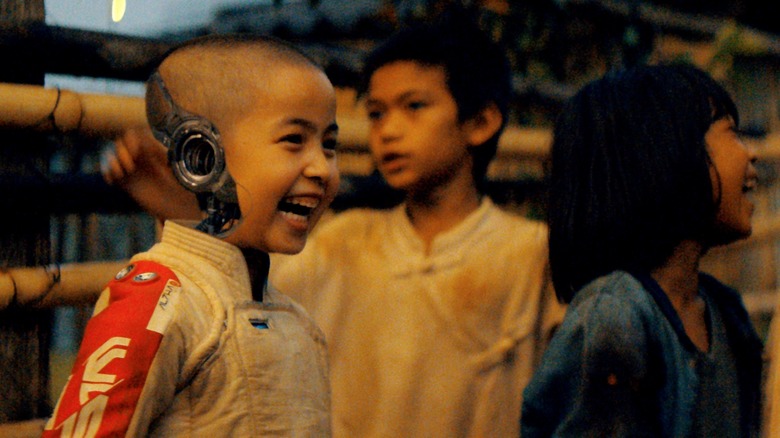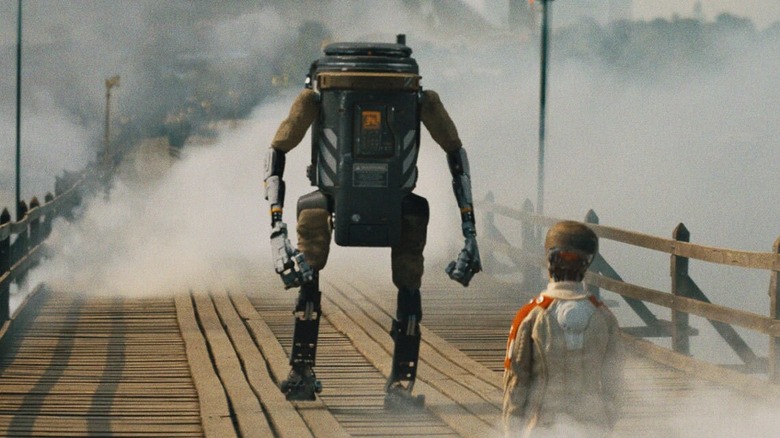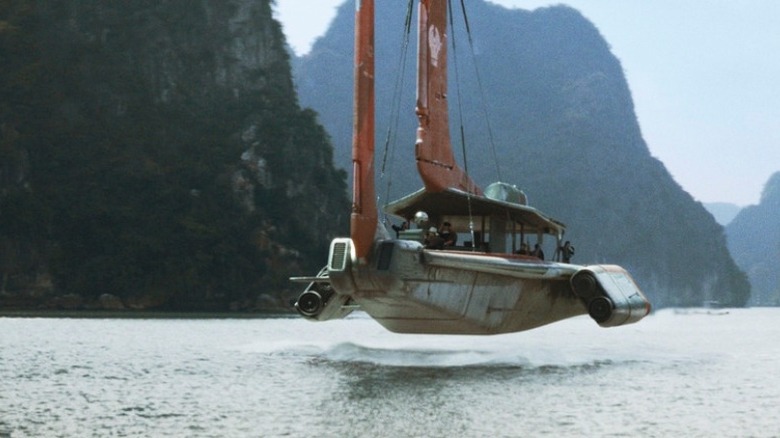How The Creator's Sci-Fi Universe Rewrites Our Past To Predict Our Future
Gareth Edwards' "The Creator" is set largely in the year 2070, which is only 47 years from the year it was made. Note that 47 years prior to the present was 1976. Although the people in 1976 likely couldn't have predicted technologies like electric cars, smartphones, and the internet, it still seems like a bold postulation that A.I. will advance as rapidly as it does in "The Creator." In the 2070 of Edwards' film, A.I. has already dropped a nuclear bomb on Los Angeles, society has largely been rebuilt, and androids with realistic human faces walk among us. Indeed, robots have formed their own societies and villages and cultures.
An opening montage, however, implies that "The Creator" takes place in an alternate history where robots were explored in the 1950s, but advanced rapidly, gaining sentience shortly thereafter. There are grainy news clips of humanoid androids on auto assembly lines as early as what looks like the 1960s. That rebooted timeline would give android societies that much more time to evolve, to perpetuate themselves, and to become the fully-formed cultures seen in the film. Edwards himself referred to the film as being a piece of retro-futurism, having been inspired by Nintendo's video console designs.
There is a lot about, however, the future of "The Creator" that the film doesn't quite make explicit. For instance, when exactly did robots come to form their own consciousness? Was there a "Skynet became self-aware" moment? And how much time passed between the consciousness flashpoint and the moment a nuclear bomb dropped? "The Creator" skips over the moment that robots when from pre-programmed helpers around the house to full-blown people.
One thing is assumed to be true in most A.I. stories: A.I. will take one look at humanity and decide to bomb us into the Stone Age.
The post-war boom
The timeline of "The Creator" makes a certain amount of logical sense, if we're to accept that the development of advanced robots first began in America in the 1950s. World War II was a devastating time, of course, but also provided a boon to the American economy. At the end of the war, many industries took off in the United States, creating a boom in auto manufacturing, food production, appliance sales, and homebuilding. The suburbs formed. If you were a white, straight, middle-class white man, the 1950s were built for you to thrive. Highways were built to accommodate the growing car population of the U.S., and car-based cultures formed. Drive-throughs, drive-ins, drive-ups. The car became a cultural fulcrum. Never mind that their leaded gas was belching toxins into the air.
Imagine that, in addition to cars, robots were included. That computer technology advanced from the reel-to-reel phases to the microcircuitry phase even more quickly than we advanced from a WWII combat plane to a full-blown commercial airliner. Typically, microtechnology (i.e. computers) and macrotechnology (i.e. transportation) take turns advancing; one with remain relatively slow-growing while the other experiences booms, and then they will swap. The twist in "The Creator" is that both mico- and macrotehcnology experienced massive post-War booms simultaneously, leading to both the creation of the suburbs as well as a mechanical workforce.
Of course, if you weren't a straight white male in the 1950s, life wasn't so rosy. Institutionalized racism and sexism as homophobia were still the law of the land, and the era was marked by both oppression and repression. A fight began in earnest to grant rights to those who didn't have them, a fight that continues to this day.
"The Creator," then, may be a comment on America's dark 1950s legacy.
Livin' in the '50s
The legacy of the 1950s lingers frustratingly into America's present. Although its attitudes predate the 1950s, many sociologists might point to the era as the flashpoint of modern American conservatism. It was the time when a lot of modern right-wing political attitudes calcified into something a citizen in 2023 might recognize. It certainly didn't help that the 1980s saw a boom in 1950s nostalgia, extending the era's attitudes into a new generation. By the 1980s America had fought a war in Vietnam — a conflict that appears to be a notable reference point for "The Creator." Indeed, portions of "The Creator" were filmed in Cambodia, the site of multiple American military operations in 1970. There are many references to "the Americans" coming to invade, to trash the local villages, and to murder robots without remorse.
It's also, however, an overseas conflict inspired by a single traumatic terrorist attack, so there are also echoes of 9/11 and the military revenge thinking that pervaded the 2000s. In the world of "The Creator," all of America's quagmires are rolled into one. It posits a world where technology advanced quickly, but so too did America's propensity for international invasion and mass destruction. Fast-forward to 2070, and humanity has built a terrifying, suborbital death plane — the NOMAD — that can scan villages for enemies and bomb them a moment later. It's essentially a drone the size of the Starship Enterprise.
By the measure of "The Creator," technology will be used to create life, and then, just as quickly, to create death. "The Creator" is very ambivalent in its views toward technology. It will bring wonders and horrors in equal measure.
And, ultimately, the machines will prove themselves to be more human than we ever were.


